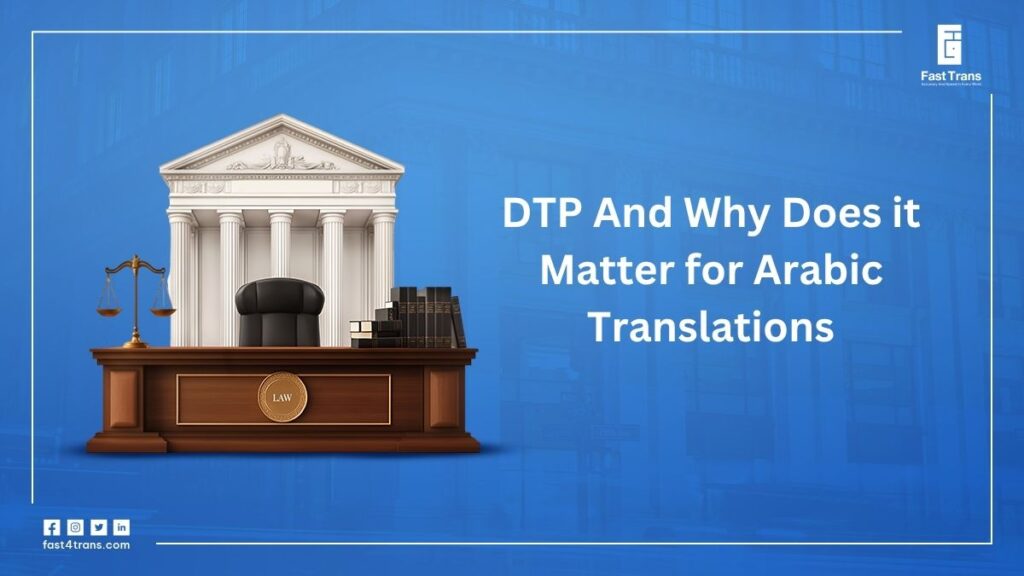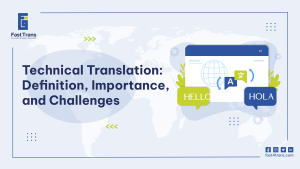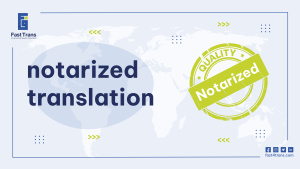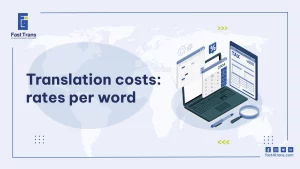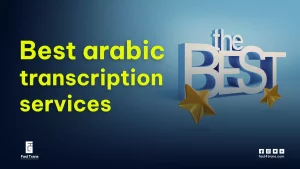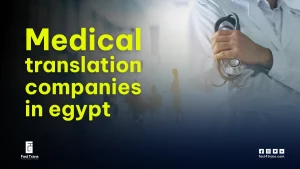In today’s global marketplace, translation is about more than just converting words from one language to another; it’s also about ensuring that the final product looks professional, polished, and culturally appropriate.
This is where Desktop Publishing (DTP) comes in. DTP refers to the use of specialized software to design and format documents, combining text, images, and layout into a visually appealing final product.
For translations, especially into languages like Arabic, DTP is not just an added step; it is essential. Arabic’s right-to-left script, unique fonts, and complex ligatures pose challenges that can easily disrupt formatting if not handled correctly. A document that reads well but looks poorly formatted can undermine credibility, confuse readers, or even change the intended message.
By connecting content and presentation, DTP ensures that translated materials not only convey meaning accurately but also maintain professionalism, readability, and cultural sensitivity.
What is Desktop Publishing (DTP)?
Desktop Publishing (DTP) is the process of using computer software to design, arrange, and produce documents that are visually appealing and ready for print or digital distribution. Unlike simple word processing, which focuses mainly on text, DTP brings together layout, typography, images, graphics, and formatting to create professional-quality materials such as brochures, manuals, reports, flyers, and books.
DTP plays a crucial role in ensuring that documents are not only informative but also easy to read and aesthetically consistent. Whether it’s adjusting margins for readability, aligning text with images, or choosing the right font styles, every detail contributes to how effectively the message is delivered.
Why DTP Matters in Translations
When translating content, accuracy in language is only part of the equation. Equally important is how the final document looks and feels to the reader. This is where Desktop Publishing (DTP) becomes critical.
1. Maintains Formatting and Layout
A translation often changes text length and structure; sentences may expand or contract depending on the language. DTP ensures that the translated text fits naturally into the original layout without breaking design elements or causing awkward spacing.
2. Preserves Readability and Flow
A document must remain easy to read and visually balanced after translation. Proper DTP ensures smooth text alignment, correct line spacing, and logical placement of images and captions, making the content comfortable for the target audience to consume.
3. Protects Professional Image and Credibility
Poorly formatted translations, such as misaligned text, inconsistent fonts, or broken layouts, can make even the best content look unprofessional. High-quality DTP maintains brand identity and reinforces trust in the organization.
4. Addresses Multilingual Design Challenges
Different languages come with unique design needs: Arabic and Hebrew require right-to-left layouts, while German or French may expand text length by up to 30%. DTP ensures each language version maintains the same visual integrity as the source.
5. Ensures Cultural and Contextual Accuracy
Beyond technical formatting, DTP also adapts visuals, colors, and symbols to suit cultural expectations. For Arabic materials, for instance, this might include ensuring that graphics align properly with RTL text and that culturally sensitive design elements are respected.
Unique Challenges of Arabic in DTP
Working with Arabic in Desktop Publishing introduces challenges that go beyond direct translation. The script, orientation, and stylistic nuances require special attention to ensure professional and accurate results. Some of the most common challenges include:
1. Right-to-Left (RTL) Alignment
Unlike English and many other languages, Arabic is written from right to left. This affects not just text direction but also the overall layout, including page flow, tables, bullet points, and the positioning of images or graphics. A document that ignores RTL alignment risks confusing readers and appearing poorly designed.
2. Handling Arabic Fonts and Calligraphy
Arabic script has rich calligraphic traditions, and not all fonts are suitable for professional documents. Choosing the right font is crucial for readability, aesthetics, and cultural appropriateness. Some fonts may also lack full character support, leading to broken text or missing symbols.
3. Issues with Diacritics, Ligatures, and Justification
Arabic writing often includes diacritics (harakat) that affect pronunciation and meaning. Proper ligatures, where characters connect smoothly, are also essential for readability. Automatic text justification in some software may create unnatural spacing, split words incorrectly, and break the flow.
4. Number Formatting and Mixed Text (Arabic + English)
Documents often include numbers, dates, or technical terms in English within Arabic text. This mix of RTL and LTR content can cause misalignment or disordered sequences if not handled carefully. For example, phone numbers, equations, or product codes may appear reversed.
5. Compatibility Problems with Some DTP Software
Not all publishing tools fully support the Arabic script. While programs like Adobe InDesign have strong RTL features, others may struggle with Arabic fonts, alignment, or justification. This can result in extra workarounds, plug-ins, or manual adjustments to achieve a professional finish.
The Role of DTP Specialists in Arabic Translation
Translating Arabic documents is not just about converting text; it’s also about ensuring that the final product is visually accurate, professional, and culturally appropriate. This is where DTP specialists play a vital role, working hand in hand with translators to deliver polished results.
1. Collaboration Between Translators and DTP Experts
Translators focus on linguistic accuracy, while DTP specialists ensure that the translated content fits seamlessly into the design. Together, they balance meaning with presentation, resolving issues like text expansion, alignment, or font compatibility.
2. Proofreading After Layout
Even with expert translation and design, errors can slip in during formatting. Proofreading after layout is essential to catch issues such as misplaced diacritics, reversed numbers, broken ligatures, or misaligned text boxes before the document is finalized.
3. Industries Where This Is Critical
- Legal: Contracts, certificates, and government documents must be both accurate and professionally formatted for official acceptance.
- Medical: Patient information, research papers, and pharmaceutical labels require clarity and precision to avoid life-threatening mistakes.
- Technical Manuals: Engineering, automotive, and IT documentation must maintain structured layouts, diagrams, and instructions in Arabic.
- Marketing: Brochures, websites, and advertising campaigns must not only read well but also look visually appealing to build trust with Arabic-speaking audiences.
By combining language expertise with design precision, DTP specialists ensure that Arabic translations are not only correct in meaning but also professional in presentation.
Read Also: Key Benefits of Arabic Professional Translation Services for Your Business
Benefits of Professional DTP in Arabic Translations
Investing in professional Desktop Publishing for Arabic translations provides significant advantages that go far beyond appearance. It directly impacts accuracy, user experience, and brand credibility.
1. Ensures Accuracy and Readability
Proper DTP guarantees that Arabic text is displayed correctly, with attention to alignment, ligatures, and diacritics. This makes the final document not only accurate in meaning but also easy and comfortable to read.
2. Preserves Brand Identity and Aesthetics
Consistency in fonts, colors, and layouts helps maintain a brand’s visual identity across different languages. Professional DTP ensures that translated Arabic documents look just as polished and trustworthy as the original.
3. Enhances User Experience Across Materials
Whether it’s a technical manual, brochure, website, or e-learning module, well-designed Arabic layouts improve navigation and comprehension. Readers engage more effectively with content that is visually clear and culturally appropriate.
4. Saves Time and Prevents Costly Rework
Correcting formatting issues after a document is published can be expensive and time-consuming. Professional DTP anticipates potential problems, like text overflow, RTL misalignment, or font incompatibility, and fixes them early, avoiding costly delays.
Example of DTP in Action
Imagine a company creating a user manual for a new medical device. The original manual is in English and needs to be translated into Arabic for distribution in the Middle East.
– Without DTP:
The translation is inserted into the original layout without adjustments. Sentences expand, causing text to overflow into diagrams. The right-to-left script pushes tables and bullet points out of alignment, numbers appear reversed, and the chosen font doesn’t support proper Arabic ligatures.
The result is confusing, unprofessional, and potentially dangerous if medical instructions are misunderstood.
– With Professional DTP:
A DTP specialist reformats the layout for Arabic. The document is mirrored to follow right-to-left flow, diagrams are repositioned to match the text direction, and a professional Arabic font ensures readability.
Tables, numbers, and multilingual terms (like English technical codes) are aligned correctly. The final manual looks polished, accurate, and safe to use, equivalent in quality to the original English version.
This example shows how DTP transforms translations from raw text into functional, professional documents. For industries like medical, legal, or marketing, this step is not optional; it’s essential.
Read Also: Expanding to the Middle East With Arabic Website Translation and Localization
Why Choose Fast Trans for Arabic DTP and Translation?
When it comes to Arabic translations, getting the words right is only half the job; the presentation matters just as much. At Fast Trans, we specialize in Desktop Publishing (DTP) for Arabic, ensuring that your documents are not only accurate in meaning but also visually polished, professional, and culturally appropriate.
Our team of expert linguists and DTP specialists works hand in hand to handle the unique challenges of Arabic: right-to-left formatting, font compatibility, ligatures, diacritics, and mixed-language layouts.
No matter the industry, legal, medical, technical, or marketing, Fast Trans is your trusted partner for Arabic DTP and translation, helping you communicate with confidence in every market.
Contact us today via our official website
What Our Customers Say
Since the translation project is theirs, we encourage the clients to discuss every stage of the process.
You can check our clients’ comments for yourself at Google Reviews.
Conclusion
Desktop Publishing (DTP) is more than a finishing touch; it is a vital part of the translation process, especially for languages like Arabic with unique formatting needs.
For businesses, institutions, and organizations entering Arabic-speaking markets, overlooking DTP can mean the difference between a message that resonates and one that fails. With professional Arabic DTP services, such as those offered by Fast Trans, you can be confident that your translated materials will deliver both accuracy and impact, helping you communicate effectively and professionally across every platform.

